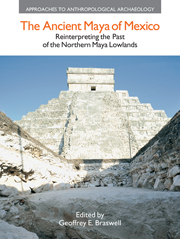Book contents
- Frontmatter
- Dedication
- Contents
- Contributors
- List of Figures
- List of Tables
- 1 The Ancient Maya of Mexico: Reinterpreting the Past of the Northern Maya Lowlands
- Part I THE PRECLASSIC PERIOD
- Part II THE EARLY AND LATE CLASSIC PERIODS
- 5 Urbanism, Architecture, and Internationalism in the Northern Lowlands during the Early Classic
- 6 The Political and Economic Organization of Late Classic States in the Peninsular Gulf Coast: The View from Champoton, Campeche
- 7 5,000 Sites and Counting: The Inspiration of Maya Settlement Studies
- Part III THE TERMINAL CLASSIC AND EARLY POSTCLASSIC PERIODS
- Part IV THE LATE POSTCLASSIC TO HISTORICAL PERIODS
- Part V CONCLUSIONS
- Index
6 - The Political and Economic Organization of Late Classic States in the Peninsular Gulf Coast: The View from Champoton, Campeche
from Part II - THE EARLY AND LATE CLASSIC PERIODS
- Frontmatter
- Dedication
- Contents
- Contributors
- List of Figures
- List of Tables
- 1 The Ancient Maya of Mexico: Reinterpreting the Past of the Northern Maya Lowlands
- Part I THE PRECLASSIC PERIOD
- Part II THE EARLY AND LATE CLASSIC PERIODS
- 5 Urbanism, Architecture, and Internationalism in the Northern Lowlands during the Early Classic
- 6 The Political and Economic Organization of Late Classic States in the Peninsular Gulf Coast: The View from Champoton, Campeche
- 7 5,000 Sites and Counting: The Inspiration of Maya Settlement Studies
- Part III THE TERMINAL CLASSIC AND EARLY POSTCLASSIC PERIODS
- Part IV THE LATE POSTCLASSIC TO HISTORICAL PERIODS
- Part V CONCLUSIONS
- Index
Summary
Abstract
Research surrounding the modern city of Champoton has focused primarily on the importance of the prehispanic polity of Chakanputun during the Postclassic period. Nevertheless, recent investigations have documented substantial evidence of much earlier cultural developments. This new research within the Rio Champoton drainage has provided important information about the political and economic organization of polities along the central Campeche coast during earlier phases of the prehispanic era. This chapter examines patterns of economic and political change that took place during the Late and Terminal Classic periods, focusing specifically on shifting patterns of political affiliation, settlement patterns, and the changing role of Gulf Coast groups in interregional exchange networks.
The Rio Champoton basin of Campeche, Mexico, was the territory of the ancient Maya province of Chakanputun, a late Maya polity well documented in Spanish ethnohistorical sources (Figure 1.1; Ruz Lhuillier 1969; Scholes and Roys 1968; Vargas Pacheco 1994, 2001). Chakanputun was one of several important yet poorly understood states located along the Gulf Coast periphery of the Maya area that rose to prominence late in the prehispanic era. Data from recent investigations by the Champoton Regional Settlement Survey (CRSS) at several sites within the surrounding region reflect a disjunction between inland and coastal zones during the latter part of the Late Classic and into the Terminal Classic, with demographic expansion along the coastal margin. This shift was associated with changes in ceramic sphere affiliation and increasing participation in coastal trade networks.
I begin this chapter with a review of the archaeology of the Gulf Coast periphery of the Maya lowlands, and discuss influential theories about the role of local groups in larger-scale cultural dynamics.
- Type
- Chapter
- Information
- The Ancient Maya of MexicoReinterpreting the Past of the Northern Maya Lowlands, pp. 143 - 169Publisher: Acumen PublishingPrint publication year: 2012

